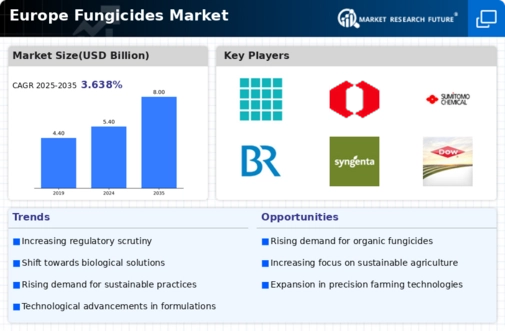Increasing Incidence of Plant Diseases
The rising prevalence of plant diseases poses a significant challenge to agricultural productivity in Europe, thereby driving the fungicides market. Factors such as climate change and monoculture practices contribute to the emergence of new pathogens, necessitating effective disease management solutions. The fungicides market is responding to this challenge, with the market projected to reach €3 billion by 2026, reflecting a compound annual growth rate of 4.5%. This growth is indicative of the urgent need for effective fungicides to combat diseases like powdery mildew and downy mildew, which threaten crop yields. Consequently, the demand for innovative fungicide solutions is expected to rise, further propelling market expansion.
Rising Demand for Sustainable Agriculture
The increasing emphasis on sustainable agricultural practices is a pivotal driver for the fungicides market in Europe. Farmers are progressively adopting eco-friendly methods to enhance crop yield while minimizing environmental impact. This shift is reflected in the growing market for bio-based fungicides, which is projected to reach €1.5 billion by 2027, accounting for approximately 30% of the total fungicides market. The demand for sustainable solutions is further fueled by consumer preferences for organic produce, compelling manufacturers to innovate and develop products that align with these values. Consequently, the fungicides market is witnessing a transformation, as stakeholders prioritize sustainability in their product offerings.
Growing Awareness of Crop Health Management
The increasing awareness of the importance of crop health management is a key driver for the fungicides market in Europe. Farmers are recognizing that proactive disease management strategies can lead to improved yields and profitability. This awareness is fostering a shift towards integrated pest management (IPM) practices, which incorporate fungicides as part of a holistic approach to crop protection. The fungicides market is witnessing a surge in demand for products that support IPM strategies, with an estimated market growth of 6% anticipated over the next five years. This trend underscores the need for fungicides that not only control diseases but also promote overall plant health, thereby enhancing the sustainability of agricultural practices.
Technological Advancements in Crop Protection
Technological innovations play a crucial role in shaping the fungicides market in Europe. The integration of precision agriculture techniques, such as drone technology and data analytics, enables farmers to apply fungicides more efficiently and effectively. This not only reduces the quantity of chemicals used but also enhances crop protection strategies. The market for advanced fungicides is expected to grow at a CAGR of 5% from 2025 to 2030, driven by these technological advancements. As a result, the fungicides market is likely to experience increased investment in research and development, leading to the introduction of novel formulations and application methods that cater to the evolving needs of farmers.
Regulatory Changes and Compliance Requirements
Regulatory frameworks governing the use of agricultural chemicals are evolving, significantly impacting the fungicides market in Europe. Stricter regulations aimed at reducing chemical residues in food products compel manufacturers to reformulate existing products and develop new, compliant solutions. The fungicides market is adapting to these changes, with an estimated 20% of the market being influenced by regulatory compliance costs. This necessitates investment in research and development to ensure that products meet safety standards while remaining effective against plant diseases. As a result, the fungicides market is likely to see a shift towards safer, more sustainable formulations that align with regulatory expectations.


















Leave a Comment